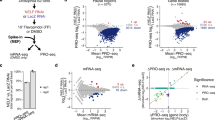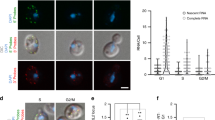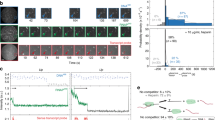Abstract
Regulation of gene expression is integral to the development and survival of all organisms. Transcription begins with the assembly of a pre-initiation complex at the gene promoter1, followed by initiation of RNA synthesis and the transition to productive elongation2,3,4. In many cases, recruitment of RNA polymerase II (Pol II) to a promoter is necessary and sufficient for activation of genes. However, there are a few notable exceptions to this paradigm, including heat shock genes and several proto-oncogenes, whose expression is attenuated by regulated stalling of polymerase elongation within the promoter-proximal region5,6,7,8,9,10,11,12,13. To determine the importance of polymerase stalling for transcription regulation, we carried out a genome-wide search for Drosophila melanogaster genes with Pol II stalled within the promoter-proximal region. Our data show that stalling is widespread, occurring at hundreds of genes that respond to stimuli and developmental signals. This finding indicates a role for regulation of polymerase elongation in the transcriptional responses to dynamic environmental and developmental cues.
This is a preview of subscription content, access via your institution
Access options
Subscribe to this journal
Receive 12 print issues and online access
$209.00 per year
only $17.42 per issue
Buy this article
- Purchase on Springer Link
- Instant access to full article PDF
Prices may be subject to local taxes which are calculated during checkout






Similar content being viewed by others
Accession codes
References
Roeder, R.G. Transcriptional regulation and the role of diverse coactivators in animal cells. FEBS Lett. 579, 909–915 (2005).
Luse, D.S. & Samkurashvili, I. The transition from initiation to elongation by RNA polymerase II. Cold Spring Harb. Symp. Quant. Biol. 63, 289–300 (1998).
Shilatifard, A., Conaway, R.C. & Conaway, J.W. The RNA polymerase II elongation complex. Annu. Rev. Biochem. 72, 693–715 (2003).
Sims, R.J. III, Belotserkovskaya, R. & Reinberg, D. Elongation by RNA polymerase II: the short and long of it. Genes Dev. 18, 2437–2468 (2004).
Aida, M. et al. Transcriptional pausing caused by NELF plays a dual role in regulating immediate-early expression of the junB gene. Mol. Cell. Biol. 26, 6094–6104 (2006).
Gilmour, D.S. & Lis, J.T. RNA polymerase II interacts with the promoter region of the noninduced hsp70 gene in Drosophila melanogaster cells. Mol. Cell. Biol. 6, 3984–3989 (1986).
Krumm, A., Hickey, L.B. & Groudine, M. Promoter-proximal pausing of RNA polymerase II defines a general rate-limiting step after transcription initiation. Genes Dev. 9, 559–572 (1995).
Krumm, A., Meulia, T., Brunvand, M. & Groudine, M. The block to transcriptional elongation within the human c-myc gene is determined in the promoter-proximal region. Genes Dev. 6, 2201–2213 (1992).
Law, A., Hirayoshi, K., O'Brien, T. & Lis, J.T. Direct cloning of DNA that interacts in vivo with a specific protein: application to RNA polymerase II and sites of pausing in Drosophila. Nucleic Acids Res. 26, 919–924 (1998).
Lis, J. Promoter-associated pausing in promoter architecture and postinitiation transcriptional regulation. Cold Spring Harb. Symp. Quant. Biol. 63, 347–356 (1998).
Rougvie, A.E. & Lis, J.T. Postinitiation transcriptional control in Drosophila melanogaster. Mol. Cell. Biol. 10, 6041–6045 (1990).
Saunders, A., Core, L.J. & Lis, J.T. Breaking barriers to transcription elongation. Nat. Rev. Mol. Cell Biol. 7, 557–567 (2006).
Strobl, L.J. & Eick, D. Hold back of RNA polymerase II at the transcription start site mediates down-regulation of c-myc in vivo. EMBO J. 11, 3307–3314 (1992).
Rasmussen, E.B. & Lis, J.T. In vivo transcriptional pausing and cap formation on three Drosophila heat shock genes. Proc. Natl. Acad. Sci. USA 90, 7923–7927 (1993).
Rasmussen, E.B. & Lis, J.T. Short transcripts of the ternary complex provide insight into RNA polymerase II elongational pausing. J. Mol. Biol. 252, 522–535 (1995).
Rougvie, A.E. & Lis, J.T. The RNA polymerase II molecule at the 5′ end of the uninduced hsp70 gene of D. melanogaster is transcriptionally engaged. Cell 54, 795–804 (1988).
Aiyar, S.E. et al. Attenuation of estrogen receptor alpha-mediated transcription through estrogen-stimulated recruitment of a negative elongation factor. Genes Dev. 18, 2134–2146 (2004).
Fujinaga, K. et al. The ability of positive transcription elongation factor B to transactivate human immunodeficiency virus transcription depends on a functional kinase domain, cyclin T1, and Tat. J. Virol. 72, 7154–7159 (1998).
Raschke, E.E., Albert, T. & Eick, D. Transcriptional regulation of the Ig kappa gene by promoter-proximal pausing of RNA polymerase II. J. Immunol. 163, 4375–4382 (1999).
Adelman, K. et al. Efficient release from promoter-proximal stall sites requires transcript cleavage factor TFIIS. Mol. Cell 17, 103–112 (2005).
Boehm, A.K., Saunders, A., Werner, J. & Lis, J.T. Transcription factor and polymerase recruitment, modification, and movement on dhsp70 in vivo in the minutes following heat shock. Mol. Cell. Biol. 23, 7628–7637 (2003).
Pokholok, D.K. et al. Genome-wide map of nucleosome acetylation and methylation in yeast. Cell 122, 517–527 (2005).
Qi, Y. et al. High-resolution computational models of genome binding events. Nat. Biotechnol. 24, 963–970 (2006).
Kim, T.H. et al. A high-resolution map of active promoters in the human genome. Nature 436, 876–880 (2005).
Lee, T.I. et al. Control of developmental regulators by Polycomb in human embryonic stem cells. Cell 125, 301–313 (2006).
Wu, C.H. et al. NELF and DSIF cause promoter proximal pausing on the hsp70 promoter in Drosophila. Genes Dev. 17, 1402–1414 (2003).
Narita, T. et al. Human transcription elongation factor NELF: identification of novel subunits and reconstitution of the functionally active complex. Mol. Cell. Biol. 23, 1863–1873 (2003).
Yamaguchi, Y., Inukai, N., Narita, T., Wada, T. & Handa, H. Evidence that negative elongation factor represses transcription elongation through binding to a DRB sensitivity-inducing factor/RNA polymerase II complex and RNA. Mol. Cell. Biol. 22, 2918–2927 (2002).
Wang, X., Lee, C., Gilmour, D.S. & Gergen, J.P. Transcription elongation controls cell fate specification in the Drosophila embryo. Genes Dev. 21, 1031–1036 (2007).
Lee, C.Y. et al. Genome-wide analyses of steroid- and radiation-triggered programmed cell death in Drosophila. Curr. Biol. 13, 350–357 (2003).
Acknowledgements
The authors acknowledge T. Kunkel, M. Resnick, G. dos Santos and P. Wade for critical reading of this manuscript. We also thank R. Young for providing support in the microarray analysis of ChIP-chip data and for helpful suggestions on this work. We thank D. Gilmour for the gift of the NELF-E antibody and for advice on permanganate mapping. This research was supported by the Intramural Research Program of the US National Institutes of Health, National Institute of Environmental Health Sciences.
Author information
Authors and Affiliations
Contributions
K.A. and G.W.M. designed the experiments and prepared the manuscript. G.W.M., D.A.G. and S.N. carried out the experiments. S.F.G. conducted the hybridization of DNA and expression arrays. J.Z. designed the DNA arrays and analyzed the bound regions in ChIP-chip data. R.S., J.S.P. and K.A. carried out further data analysis.
Corresponding author
Supplementary information
Supplementary Text and Figures
Supplementary Methods, Supplementary Figures 1–8 (PDF 2298 kb)
Supplementary Table 1
Supplementary Table 1 (XLS 1214 kb)
Supplementary Table 2
Supplementary Table 2 (XLS 108 kb)
Supplementary Table 3
Supplementary Table 3 (XLS 36 kb)
Rights and permissions
About this article
Cite this article
Muse, G., Gilchrist, D., Nechaev, S. et al. RNA polymerase is poised for activation across the genome. Nat Genet 39, 1507–1511 (2007). https://doi.org/10.1038/ng.2007.21
Received:
Accepted:
Published:
Issue Date:
DOI: https://doi.org/10.1038/ng.2007.21
This article is cited by
-
PRO-IP-seq tracks molecular modifications of engaged Pol II complexes at nucleotide resolution
Nature Communications (2023)
-
Genomic regulation of transcription and RNA processing by the multitasking Integrator complex
Nature Reviews Molecular Cell Biology (2023)
-
Lola-I is a promoter pioneer factor that establishes de novo Pol II pausing during development
Nature Communications (2023)
-
Dependency of NELF-E-SLUG-KAT2B epigenetic axis in breast cancer carcinogenesis
Nature Communications (2023)
-
The chromatin remodeler Ino80 mediates RNAPII pausing site determination
Genome Biology (2021)



